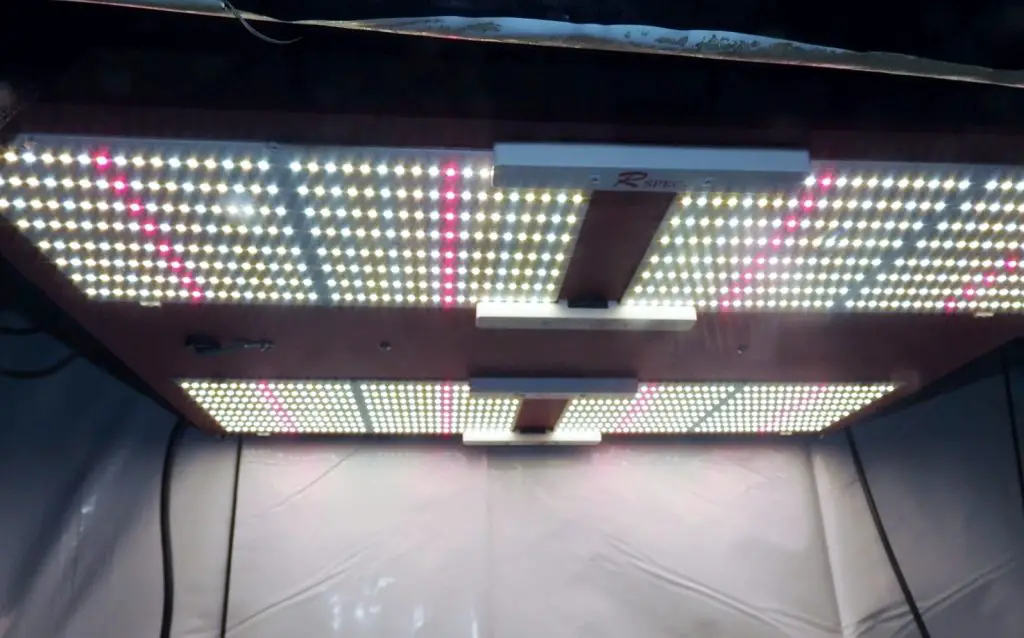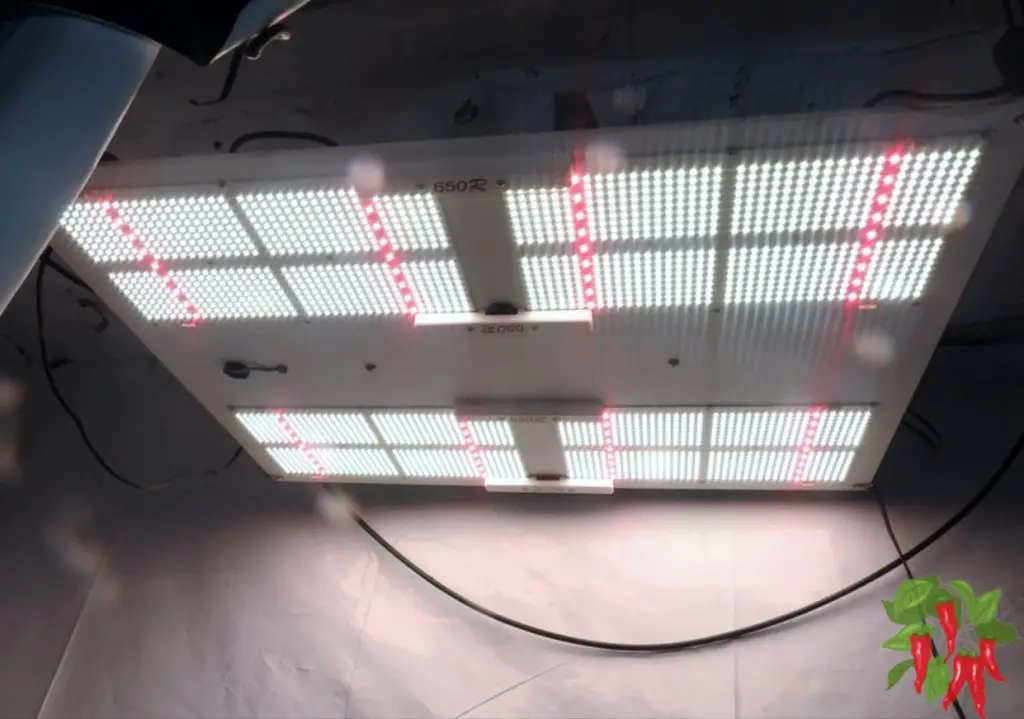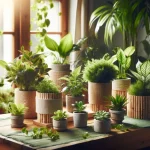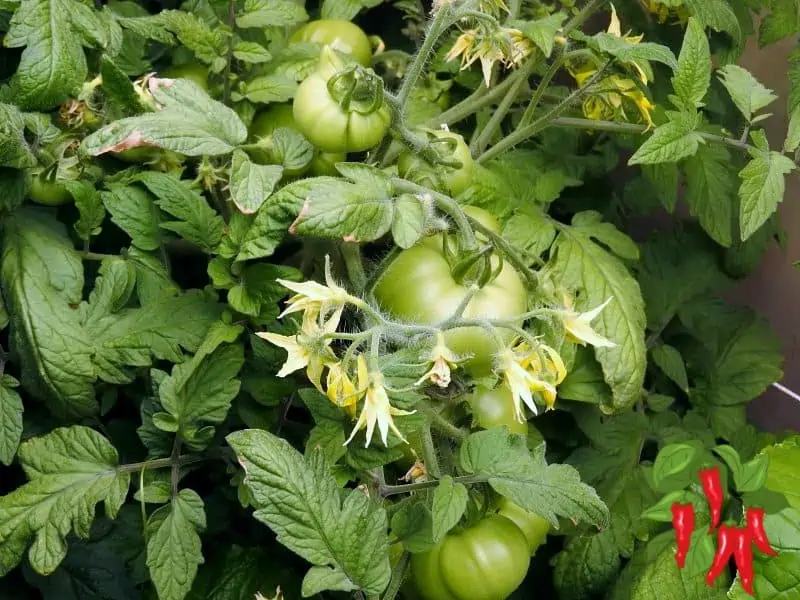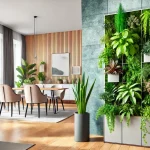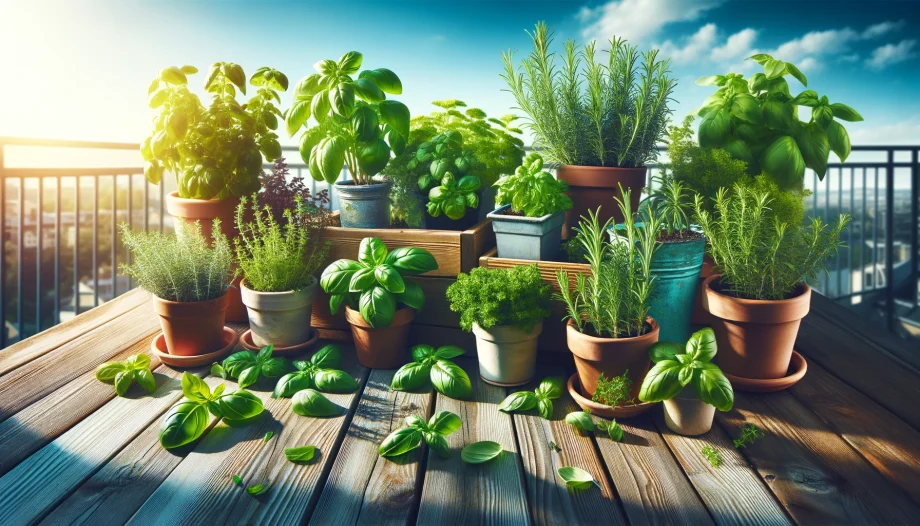This post may contain affiliate links. If you buy something from one of our links we may earn a commission. Thanks
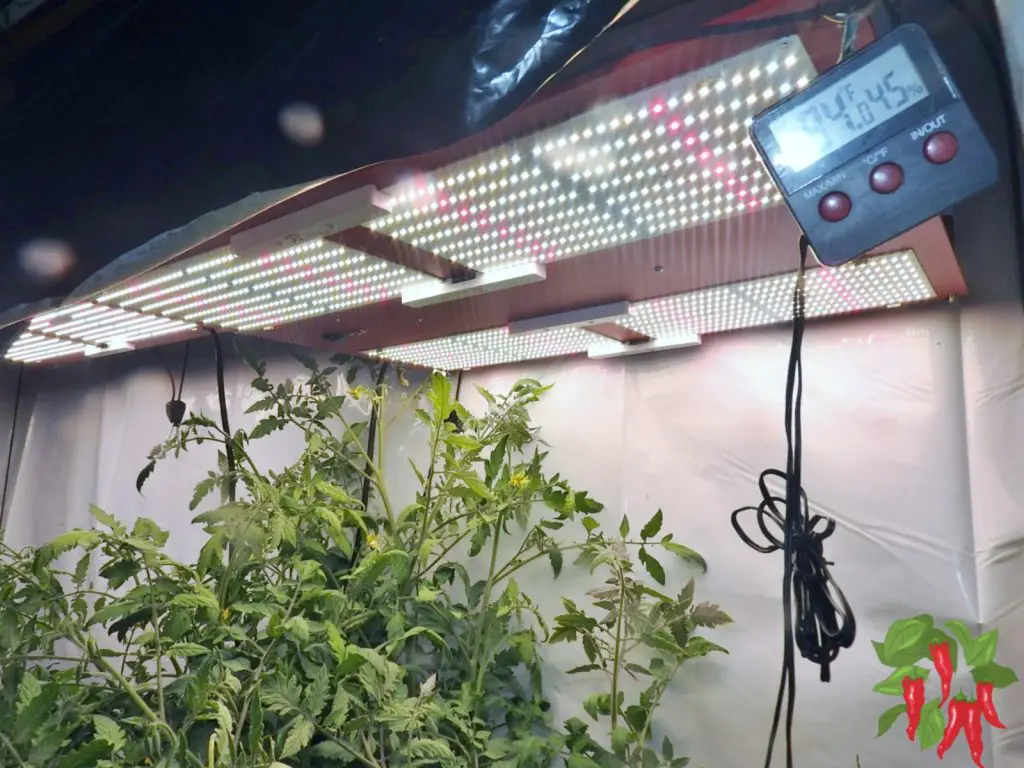
If you want to grow plants indoors and are wondering how many watts per square foot for LED lighting, then dive into our guide to LED efficiency and lighting!
Ever found yourself scratching your head, wondering how many watts per square foot for LED lighting is ideal? Well, you’re not alone.
It’s a common question, especially when you’re trying to create the perfect lighting conditions.
Whether you’re setting up an indoor garden or optimizing your workspace, understanding the right wattage for your LED lights can make a world of difference.
In this blog post, we’ll shed some light (pun intended!) on this topic and help you navigate the world of LED lighting with ease. So, let’s flip the switch and get started!
How Many Watts Per Square Foot For Led Lighting?
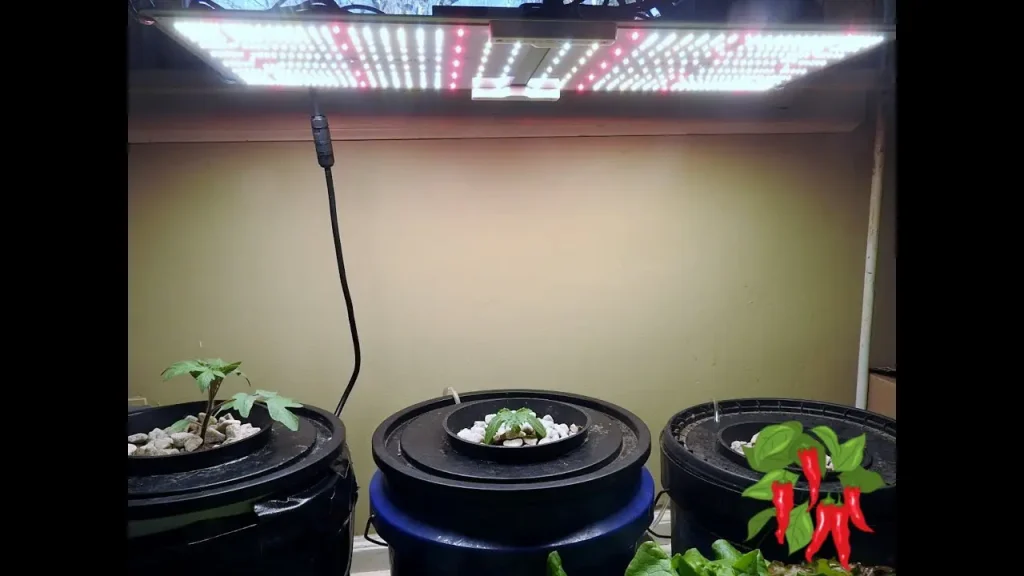
Welcome to our deep dive into the world of LED lighting! Today, we’re tackling the question: How many watts per square foot for LED lighting?
It’s a topic that might seem a bit technical at first, but don’t worry, we’re going to break it down into bite-sized, easy-to-understand pieces.
We’ll explore everything from the basics of understanding watts per square foot, to the factors that influence your LED choice, and even the different growing techniques and their unique lighting needs.
We’ve also included a handy FAQ section to answer some of the most common queries.
So, whether you’re a seasoned pro or a beginner in the world of LED lighting, this post has something for you. Let’s jump right in!
Importance of Correct LED Lighting Wattage
Choosing the correct LED lighting wattage is more than just a numbers game. It’s about creating the right environment for your needs, whether that’s growing lush indoor plants or setting up an efficient workspace.
Too little wattage and you might not get the light output you need. Too much, and you risk wasting energy and possibly overwhelming your space with too much light.
It’s a delicate balance, but don’t worry, we’re here to help you find it. Remember, the goal is to achieve the perfect harmony of light, space, and energy efficiency.
Brief Overview of LED Lighting Efficiency
Now, let’s talk about LED lighting efficiency. LEDs, or Light Emitting Diodes, have revolutionized the lighting industry with their superior energy efficiency and longevity.
Compared to traditional lighting options, LEDs use significantly less energy to produce the same amount of light.
This means lower electricity bills and a smaller carbon footprint, which is a win-win situation!
But that’s not all. LEDs also have a longer lifespan, meaning you won’t need to replace them as often.
This efficiency makes LEDs a smart choice for anyone looking to optimize their lighting setup.
So, when we talk about how many watts per square foot for LED lighting, we’re really talking about how to make the most of these amazing benefits.
Understanding Watts Per Square Foot

Ready to dive deeper into the world of LED lighting? Great! Our next stop is understanding watts per square foot.
This might sound like a phrase straight out of a physics textbook, but trust me, it’s not as complicated as it seems.
In fact, it’s a pretty straightforward concept that can make a huge difference in your lighting setup.
So, whether you’re lighting up a cozy reading nook or an entire indoor garden, understanding watts per square foot is your ticket to creating the perfect lighting conditions. Let’s get started!
Definition of Watts Per Square Foot
Let’s start with the basics. What exactly do we mean when we say watts per square foot?
Well, in the simplest terms, it’s a measure of how much light energy (measured in watts) is being used to light up a specific area (measured in square feet).
Think of it as a way to gauge the intensity of your lighting. For example, if you have a 100-watt LED light illuminating a 10-square-foot area, you’re using 10 watts per square foot. Easy, right?
Importance of Watts Per Square Foot in LED Lighting
Now that we’ve got the definition down, let’s talk about why watts per square foot is so important in LED lighting. The key here is balance.
You want enough light to fully illuminate your space, but not so much that you’re wasting energy or creating an uncomfortably bright environment.
That’s where watts per square foot come in. By understanding this concept, you can choose the right LED lights for your space and ensure they’re used efficiently.
Whether you’re growing plants indoors or setting up a photography studio, knowing your watts per square foot can help you create the ideal lighting conditions.
So, next time you’re choosing LED lights, remember to consider the watts per square foot. It’s a small detail that can make a big difference!
Understanding watts per square foot is measured at the wall
When we talk about watts per square foot, it’s crucial to understand that we’re referring to the actual power draw at the wall, not a theoretical number provided by the manufacturer.
This means we’re considering the real-world energy usage of the LED light, which can sometimes be different from the wattage listed on the product specifications.
Manufacturers often list the maximum potential wattage of the LED light, but the actual power draw at the wall can be lower due to factors like energy efficiency and heat loss. Most LED lights are not run at full power.
So, when calculating watts per square foot, always use the actual power draw to get the most accurate measurement.
This will ensure you’re not overestimating your lighting needs and can help you optimize your energy usage. It’s all about getting the most light out of every watt of power!
Factors That Affect LED Choice

Alright, now that we’ve got a handle on the concept of watts per square foot, let’s move on to the next piece of the puzzle: choosing your LED lights.
You might be thinking, Isn’t it just about picking the one with the right wattage? Well, yes, but there’s a bit more to it than that.
You see, several factors can influence your LED choice, and understanding these can help you make the most informed decision.
From the type of plant you’re growing (if you’re into indoor gardening) to the total area you need to illuminate, these elements play a crucial role in determining the best LED lights for your needs.
So, let’s dive in and explore these factors in more detail, shall we?
Using white or full-spectrum LEDS for plants
When it comes to growing plants indoors, the type of light you use can significantly impact their growth and health.
White or full-spectrum LEDs are often the best choice for this purpose. One that I use and recommend is the 200-watt Spider Farmer SF 2000 which can cover a 3×3 to 2×4 area.
Why is that? Well, full-spectrum LEDs emit light that covers the entire spectrum, from blue to red and everything in between.
This is similar to the light provided by the sun, which is why it’s often referred to as natural light.
Plants use different parts of the light spectrum for different growth processes. For example, blue light is essential for leaf and stem growth, while red light promotes flowering and fruiting.
By using full-spectrum LEDs, you’re ensuring your plants get all the light types they need to thrive.
So, whether you’re growing leafy greens or flowering plants, full-spectrum LEDs can provide the right light for optimal growth.
It’s one of the many factors to consider when choosing your LED lights, and it can make a big difference in your indoor gardening success.
Type of Plant
When it comes to choosing LED lights, the type of plant you’re growing plays a significant role.
Different plants have different light needs, and understanding these can help you choose the right LED lights.
For instance, leafy greens like lettuce and herbs generally do well with lower wattages. They thrive under cool, blue light, which promotes leaf and stem growth.
On the other hand, flowering and fruiting plants like tomatoes, peppers and cannabis often require higher wattages.
They benefit from red light, which encourages blooming and fruit production. Full-spectrum LEDs, which provide a balance of cool and warm light, are often the best choice for these plants.
So, when choosing your LED lights, take a moment to consider what you’re growing. The right light can make all the difference in your plant’s growth and health.
Total Area of Grow
The total area you need to illuminate, or your grow area, is another crucial factor in choosing LED lights.
This isn’t just about the size of your space. It’s about how much of that space your plants are actually using.
For example, if you’re growing a single plant in a large room, you won’t need to light up the entire room.
You’ll just need enough light for your plant. On the other hand, if you’re growing several plants spread out across the room, you’ll need more light to ensure all your plants get the light they need.
When calculating your grow area, consider the footprint of your plants, not just the size of your room.
This will help you determine how many watts per square foot you need, ensuring your plants get just the right amount of light.
The Rule of Thumb for LED Lighting
Now that we’ve explored the factors that can influence your LED choice, let’s delve into a handy guideline that can simplify the process: the rule of thumb for LED lighting.
This rule provides a quick and easy way to estimate the wattage you need for your space. But like any rule of thumb, it’s not one-size-fits-all.
It’s a starting point, a general guideline to get you in the right ballpark. From there, you can adjust based on your specific needs and the factors we discussed earlier.
So, let’s dive in and learn more about this rule of thumb and how to apply it to your LED lighting setup.
General Guideline for LED Wattage
So, what’s this rule of thumb we’re talking about? Well, it’s pretty straightforward.
Generally, for LED grow lights, the rule of thumb is to aim for about 32 watts per square foot if you’re growing high-light plants like tomatoes.
This should provide enough light for your plants to grow and thrive, without wasting energy.
This guideline is based on the average light needs of high-light plants. It’s a good starting point, but remember, every setup is unique.
Depending on your specific situation, you might need more or less wattage per square foot. That’s where the factors we discussed earlier come into play.
Exceptions to the Rule
Like any rule of thumb, the 32 watts per square foot guideline isn’t set in stone. There are exceptions to the rule, and it’s important to be aware of these.
For instance, if you’re growing low-light plants like herbs and leafy greens, you might not need as much wattage.
These plants can often do well with less intense light. On the other hand, if you’re growing in a large space or using growing techniques that spread your plants out, you might need more wattage to ensure all your plants get the light they need.
Also, remember that the actual power draw at the wall is what matters, not the manufacturer’s listed wattage.
Always base your calculations on the actual power draw to get the most accurate estimate.
So, while the 32 watts per square foot rule of thumb can be a helpful guideline, always consider your specific needs and circumstances.
The best lighting setup for you is the one that meets your unique needs and helps your plants thrive.
Different Growing Techniques and Their Lighting Needs
Let’s switch gears a bit and talk about growing techniques. Yes, you heard that right!
The way you grow your plants can actually influence your lighting needs. From the Screen of Green technique to Low-Stress Training, different methods have different light requirements.
Understanding these can help you optimize your LED lighting setup and ensure your plants get just the right amount of light.
So, whether you’re a seasoned indoor gardener or just starting out, this section is for you.
Let’s dive in and explore how different growing techniques can shape your LED lighting needs.
The techniques below were primarily adopted by cannabis growers who were working primarily with HID lighting which is much less efficient than modern LED lights. However, these techniques may still be useful for certain plants.
For example, indeterminate vining plants like tomatoes can be more easily grown and trained grown on a screen.
Screen of Green Technique
First up, let’s talk about the Screen of Green (ScroG) technique. This method involves placing a screen or net over your plants and weaving the branches through as they grow.
The goal is to create a flat canopy of buds, which can help maximize light exposure and yield.
When using the ScroG technique, it’s important to have evenly distributed light across the entire canopy.
This is where LED lights really shine. Their wide light spread is perfect for the flat canopy created by the ScroG technique.
Plus, LEDs run cooler than other types of lights, reducing the risk of heat damage to the plants close to the light.
Sea of Green Technique
Next, we have the Sea of Green (SoG) technique. This method involves growing many small plants instead of a few larger ones.
The plants are kept small by switching to the flowering stage earlier than usual. The result is a sea of small, uniform plants.
The SoG technique requires intense, well-distributed light to reach all the plants. Again, LED lights are a great choice here.
Their cool operation and wide light spread are ideal for the dense plant population in a SoG setup.
Low-Stress Training
Last but not least, we have Low-Stress Training (LST). This technique involves gently bending and tying down plant branches to create a more horizontal plant structure.
Like the ScroG technique, the goal is to maximize light exposure and yield.
With LST, you want a light source that can penetrate the lower branches of the plant.
LED lights, especially those with lenses that focus the light, can be a good choice. They can provide intense, targeted light that reaches all parts of the plant.
Remember, each growing technique has its own unique lighting needs. By understanding these, you can choose the best LED lights for your setup and help your plants thrive.
Understanding Photosynthetically Active Radiation (PAR)
Let’s now turn our attention to a term that might sound a bit scientific but is actually pretty straightforward, Photosynthetically Active Radiation, or PAR for short.
If you’re wondering what this has to do with LED lighting, well, quite a lot actually! PAR is a key factor in understanding how plants use light and, therefore, how to choose the right LED lights for your needs.
But don’t worry, we’re going to break it down in a way that’s easy to understand. So, let’s dive in and shed some light on PAR and its role in LED lighting.
Definition of PAR
Photosynthetically Active Radiation, or PAR, might sound like a mouthful, but it’s actually a pretty simple concept.
PAR refers to the range of light wavelengths that plants can use for photosynthesis. This is typically light in the 400 to 700-nanometer range, which includes both visible light and some wavelengths that are invisible to the human eye.
In other words, PAR is the part of the light spectrum that plants can actually use to grow.
Importance of PAR in Plant Growth
So, why is PAR important for plant growth? Well, photosynthesis is the process by which plants convert light energy into chemical energy, which they use to grow and reproduce.
And since PAR represents the light that plants can use for photosynthesis, it’s a key factor in plant growth. The more PAR light a plant receives, the more energy it can produce, and the better it can grow.
That’s why understanding PAR is so important for indoor gardening. It can help you provide your plants with the light they need to thrive.
How PAR Affects LED Lighting Choice
Now, let’s talk about how PAR affects your choice of LED lights. When choosing LED lights, you want to look for ones that emit light in the PAR range.
These will provide the most beneficial light for your plants. Some LED lights are even designed to emit specific wavelengths within the PAR range to promote certain aspects of plant growth.
For example, blue light can promote leaf and stem growth, while red light can encourage flowering and fruiting.
By understanding PAR and how it affects plant growth, you can choose LED lights that will best support your plants’ needs.
It’s another tool in your toolbox to help you create the perfect lighting setup for your indoor garden.
For LED lights using a par meter is a much more accurate way to measure light than watts per square foot. It is measured with a par meter.
I use a Quantum Sun Quantum Par Meter pictured here.
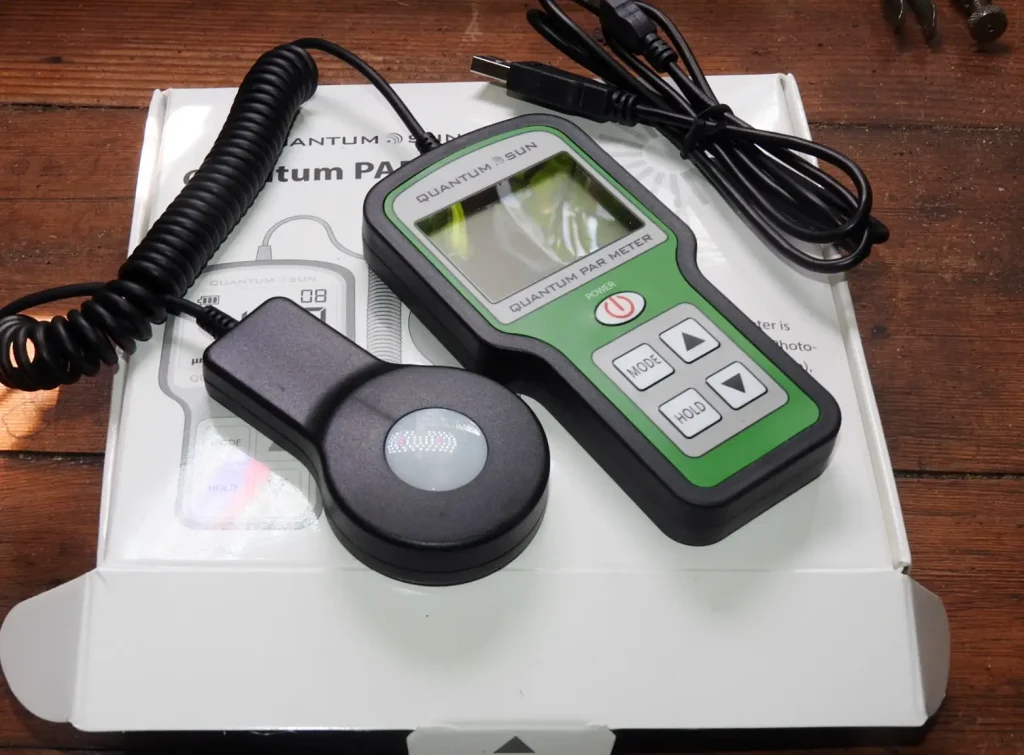
Setting Up LED Grow Lights in Indoor Spaces
Spider Farmer SF2000 LED Grow Light with Samsung LM301B Diodes
Now that we’ve covered the technical aspects of LED lighting, let’s move on to something a bit more hands-on: setting up your LED grow lights in indoor spaces.
Whether you’re setting up a small indoor garden in your living room or a larger grow operation in a dedicated space, the setup process is crucial.
It’s not just about hanging up lights and plugging them in. It’s about positioning and adjusting them to create optimal lighting conditions for your plants.
In this section, we’ll walk you through the steps to set up your LED grow lights and share some tips to maximize their potential. So, let’s roll up our sleeves and get started!
Steps to Set Up LED Grow Lights
Setting up LED grow lights might seem like a daunting task, but it’s actually quite straightforward. Here are the basic steps:
Determine Your Lighting Needs: Based on the type of plants you’re growing and the size of your grow area, determine how many watts per square foot you need.
Remember to use the actual power draw of the LED lights for your calculations.
Choose Your Lights: Select LED lights that meet your wattage needs and emit light in the PAR range. Consider lights with adjustable spectrum control if you’re growing a variety of plants.
Position Your Lights: Hang your LED lights above your plants, ensuring they cover the entire grow area.
The exact height will depend on the intensity of your lights and the light needs of your plants. Often the manufacturer will give you guidelines for hanging height.
Adjust as Needed: Monitor your plants and adjust the position or intensity of your lights as needed.
Look for signs of light stress, like leaf yellowing or curling, and adjust your lights accordingly.
Tips to Maximize LED Lighting Potential
Now, let’s look at some tips to maximize your LED lighting potential:
Use Reflective Surfaces: If possible, use reflective surfaces like Mylar or white paint on the walls of your grow area. This can help reflect light back onto your plants, increasing the overall light intensity.
Regularly Clean Your Lights: Dust and dirt can reduce the light output of your LEDs. Regularly cleaning your lights can help maintain their efficiency.
Use a Timer: LED lights can be intense, and your plants need some darkness too. Using a timer can help ensure your plants get the right balance of light and dark.
Understanding the Inverse Square Law in Lighting
Finally, it’s important to understand the inverse square law in lighting. This law states that the intensity of light is inversely proportional to the square of the distance from the light source.
In simpler terms, as you move away from the light source, the light intensity decreases rapidly.
For indoor gardening, this means that the closer your plants are to the LED lights, the more light they receive.
However, if the lights are too close, they can cause light burn. On the other hand, if the lights are too far away, your plants may not get enough light.
Understanding the inverse square law can help you position your lights at the optimal distance, maximizing their effectiveness while preventing light burn.
Let’s use the inverse square law to illustrate the difference in light intensity at 2 feet and 3 feet from the light source.
According to the inverse square law, if you double the distance from the light source (going from 1 foot to 2 feet, for example), the light intensity becomes a quarter of what it was. If you triple the distance (going from 1 foot to 3 feet), the light intensity becomes a ninth of what it was.
So, if you have a light source that provides 1000 units of light at 1 foot, it will provide 250 units of light at 2 feet and approximately 111 units of light at 3 feet.
This example illustrates how quickly light intensity decreases as you move away from the light source.
It’s a crucial consideration when positioning your LED lights in your indoor garden to ensure your plants receive the right amount of light.
FAQs
As we navigate the world of LED lighting, it’s natural to have a few questions. After all, it’s a topic that combines science, gardening, and a bit of DIY handiwork!
That’s why we’ve included this handy FAQ section. Here, we’ll tackle some of the most common questions about LED lighting and watts per square foot.
Whether you’re wondering about the ideal wattage for LED grow lights or the role of PAR in choosing LED lighting, we’ve got you covered. So, let’s dive in and answer some questions!
Q: What is the ideal wattage per square foot for LED grow lights?
A: The ideal wattage per square foot for LED grow lights can vary depending on the type of plants you’re growing and the specific conditions of your grow area.
However, a general rule of thumb is to aim for about 32 watts per square foot for high-light plants like tomatoes.
Remember, this is a guideline and your specific needs may vary. Always monitor your plants and adjust your lighting as needed.
Q: How does the type of plant affect the choice of LED lighting?
A: Different plants have different light needs, which can affect your choice of LED lighting.
For instance, leafy greens like lettuce and herbs generally do well with lower wattages and prefer cool, blue light.
On the other hand, flowering and fruiting plants like tomatoes often require higher wattages and benefit from red light.
Full-spectrum LEDs, which provide a balance of cool and warm light, are often the best choice for a variety of plants.
Q: What is the role of PAR in choosing LED lighting?
A: PAR, or Photosynthetically Active Radiation, refers to the range of light wavelengths that plants can use for photosynthesis.
When choosing LED lights, it’s important to select ones that emit light in the PAR range.
This ensures your plants are receiving light that they can actually use to grow.
Some LED lights are even designed to emit specific wavelengths within the PAR range to promote certain aspects of plant growth, like leaf and stem growth or flowering and fruiting.
Conclusion
Well, we’ve certainly covered a lot of ground in our exploration of LED lighting and the question of how many watts per square foot for LED lighting.
From understanding the basics of watts per square foot to diving into the specifics of different growing techniques and their lighting needs, we’ve shed light on the many factors that can influence your LED lighting setup.
As we wrap up, let’s take a moment to recap the key points and share some final thoughts.
Whether you’re a seasoned indoor gardener or just starting out, we hope this guide has illuminated the path to your perfect LED lighting setup. Let’s wrap things up!
Recap of Key Points
We’ve covered a lot in this post, so let’s quickly recap the key points:
Understanding Watts Per Square Foot: This is a measure of how much light energy is being used to light up a specific area. It’s a crucial concept when choosing the right LED lights for your space.
Factors That Affect LED Choice: The type of plant you’re growing and the total area you need to illuminate can significantly influence your LED choice.
The Rule of Thumb for LED Lighting: A general guideline is to aim for about 32 watts per square foot for high-light plants. However, this can vary based on your specific needs.
Different Growing Techniques and Their Lighting Needs: Techniques like the Screen of Green or Low-Stress Training can influence your lighting needs and the choice of LED lights.
Understanding PAR: PAR refers to the range of light wavelengths that plants can use for photosynthesis. Choosing LED lights that emit light in the PAR range can help ensure your plants get the light they need to thrive.
How Many Watts Per Square Foot for LED Lighting FAQ
Navigating the world of LED lighting for indoor gardening can be both exciting and a bit overwhelming.
With so many factors to consider, from watts per square foot to the specific needs of different plants, it’s natural to have a few questions.
That’s why we’ve put together this friendly FAQ section to help you on your journey to the perfect indoor garden.
Whether you’re a green-thumbed pro or just starting to explore the world of indoor growing, we’ve got answers to some of the most common questions right here.
Q: How do I know if I’m using the right wattage for my specific plants?
A: The right wattage depends on the type of plants you’re growing and the size of your grow area.
A general guideline is to aim for about 32 watts per square foot for high-light plants like tomatoes.
However, it’s essential to monitor your plants and adjust the lighting as needed, considering factors like the type of plant and the growing technique you’re using.
Q: Can I use LED lighting for any type of indoor plant, or is it specific to certain plants?
A: LED lighting is versatile and can be used for various indoor plants.
Full-spectrum LEDs are recommended as they provide a balance of light very close to natural sunlight which is suitable for all plants and different growth stages.
Q: What is PAR, and why is it important in choosing LED lights?
A: PAR, or Photosynthetically Active Radiation, refers to the range of light wavelengths that plants can use for photosynthesis.
It’s essential in choosing LED lights because it ensures that the lights emit wavelengths that the plants can actually use to grow.
White full spectrum LED lights are designed to emit specific wavelengths within the PAR range to promote certain growth aspects.
Q: How can I prevent my plants from getting too much or too little light with LED lighting?
A: Monitoring your plants for signs of light stress, like leaf yellowing or curling, is key.
If you notice any of these signs, you may need to adjust the position or intensity of your lights.
Using reflective surfaces can increase light intensity, and using a timer can help balance light and dark periods.
Understanding the inverse square law in lighting can also help you position your lights at the optimal distance to prevent too much or too little light.
Final Thoughts: Watts Per Square Foot for LED Lighting
As we wrap up, it’s important to remember that every indoor garden is unique. The best LED lighting setup for you is the one that meets your specific needs and helps your plants thrive.
Whether you’re growing a single plant or an entire indoor garden, understanding concepts like watts per square foot and PAR can help you make informed decisions about your LED lighting.
Remember, the goal is to create the perfect lighting conditions for your plants, and with the information in this post, you’re well on your way. Happy growing!
Recommended Light Spider Farmer SF2000
I no longer grow cannabis and although HLG lights are great they are expensive, The Spider Farmer is a great low-cost alternative, and here is a video I made a while back. This light can cover a 2×3 to 2×4 area for high-light plants.
Visit my Amazon Influencer Page for videos and gardening products Grow Your Own Garden

